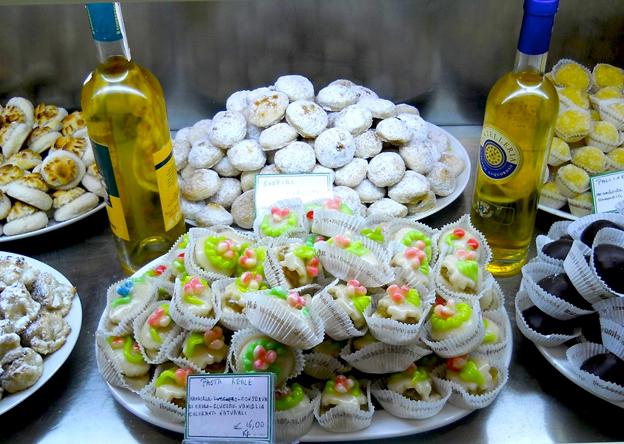Sicily’s rich tradition of ‘dolci’ has been shaped by many diverse cultural influences throughout history, from the almonds and oranges introduced by the Arabs to the cocoa beans introduced by the Spanish to the island’s industrious pastry-making nuns. Each dominant culture left behind its own cultural and gastronomic imprint, setting in motion a permanent love affair with all things sweet. We explore one heart-warming story of a modern day Sicilian legend whose famous ‘pasticcini’ are celebrated throughout Italy and beyond.
Maria Grammatico was one of six children born into a poor family in Erice, a fairytale mountain-top town in western Sicily. She recalls the hardship of life in the 1940s post WWII, often going to bed without eating, and seeing her siblings go hungry. Realising that she simply couldn’t afford to feed her children, Maria’s mother placed her in a convent (Istituto San Carlo), age 11, where she subsequently led a life of hard work and solitude. The one saving grace of this otherwise isolated existence was learning the wonderful art of making ‘pasta di mandorla’ and marzipan.
Many Sicilian nuns diligently learnt the art of making almond-based ‘pasticcini’ in an effort to sustain themselves and make a modest living. The tradition became so prevalent in the last century that convents virtually competed against each other to produce the most spectacular marzipan creations. Martorana was one such convent, hence the name ‘Frutta Martorana’ that was assigned to the many and varied marzipan fruits and figures they created. These were particularly prominent on feast days, such as the ‘Festa dei Morti’, a festival originally made popular by the Spanish. It provided the nuns, who often led very secluded lives, with a rare outlet for creativity.

Maria Grammatico at the convent
Maria and her companions at the convent would get up at dawn to begin working and rarely strayed outside the convent’s walls. The young Maria took great delight in watching the nuns as they went about the business of making the much-loved ‘pasticcini’ for the town’s people, observing the way they prepared, weighed and mixed the ingredients (using marked stones in the absence of official weights!), and observing how long they baked the different combinations.
The almonds were ground down to produce the famous 'pasta di mandorla' (almond paste, in English), or turned into marzipan by adding water and icing sugar. The resulting marzipan and pastry creations were often flavoured with cinnamon or cloves.

Nuns making pasticcini
She finally left the convent in 1963, 15 years later, and set up her own small shop, La Pasticceria di Maria Grammatico, with literally a handful of almonds and a wood stove to her name. The nuns were so jealous of her operation that she was not allowed back to the convent and they wouldn’t even give her any of the moulds they used to fashion the various different pastry shapes!
Her spirits undampened by the nuns’ hostility, Maria’s pastry-making went from strength to strength. The care she’d taken to memorise the nuns’ careful processes paid dividends. Now, her colourful shop, which sits aloft in Erice’s beautiful cobbled streets, sells a myriad of delicious pasticcini of all shapes, colours and sizes, providing a truly sensual delight to all who visit it and experience her warm welcome.

Maria still uses the nuns’ traditions to make her world-famous creations, as well as her own homemade jam and marzipan. She places a strong emphasis on using local, natural ingredients, carefully seeking milk that’s been produced by hand, and always using 100% Sicilian almonds from Avola. She has been quoted as saying that almonds are like children to her, and that she couldn’t imagine being without them – she loves to mould them to shape her exquisite culinary delights. She has become a celebrated pasticceria expert, specialising in ‘torrone’ and ‘pasta di mandorla’.
Among her many classic specialities are the ‘Seni di Vergine’ (comprised of almonds, sugar, citrus-flavoured jam),‘Quaresimali’, ‘Mostaccioli’ and ‘Paste da Risposto’, which feature intricate handmade flowers.

Maria Grammatico in her Pasticceria
 American writer Mary Taylor Simeti tells Maria Grammatico’s story in "Bitter Almonds", a book where Maria recalls her youth at the convent, her early work experiences and offers some of her famous recipes, some of of those she had "stolen" from the cloistered nuns of the San Carlo convent in Erice.
American writer Mary Taylor Simeti tells Maria Grammatico’s story in "Bitter Almonds", a book where Maria recalls her youth at the convent, her early work experiences and offers some of her famous recipes, some of of those she had "stolen" from the cloistered nuns of the San Carlo convent in Erice.












